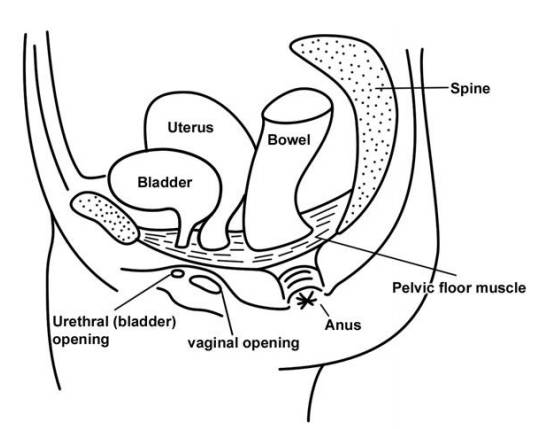Pelvic floor exercises and advice for women
Please note, this page is printable by selecting the normal print options on your computer.
This leaflet is to explain what the pelvic floor muscles do, and how to exercise them.
Where are the pelvic floor muscles?
The pelvic floor is a group of muscles like a hammock at the base of the pelvis, running from the pubic bone at the front to the tailbone at the back.
It has three openings
– the urethra (the bladder outlet)
– the vagina (birth canal)
– anus (back passage)
What do they do?

These muscles support the pelvic organs (bladder, uterus (womb) and bowels). They also help to control the bladder and bowels. Healthy pelvic floor muscles may also help improve your sex
life. Pelvic floor muscles should be kept strong just like any other muscle within the body.
What can weaken the pelvic floor?
• Pregnancy
• Childbirth (especially difficult vaginal deliveries)
• Straining regularly to open your bowels (constipation)
• Repeated heavy lifting
• Changes during the menopause
• Chronic cough, especially associated with smoking
• General lack of fitness
• Long periods of inactivity (due to illness/surgery)
• High impact, vigorous exercise or with heavy weights
Symptoms of pelvic floor weakness
• Leaking small amounts of urine on coughing, sneezing or lifting
• Sudden urgent or frequent need to pass urine
• Feeling ‘something coming down’ or a ‘dragging sensation’ in the vagina (prolapse)
• Being unable to control leakage of wind or faeces from the bowel
• Lack of sensation with sex
How to exercise the pelvic floor muscles
Start by sitting in a comfortable position, feet flat on the floor. Imagine that you are trying to stop yourself passing urine or ‘wind’, by drawing the area ‘upwards and forwards’ from bowel to bladder – then let go. Like a ‘squeezing and lifting’ movement.
• Try and hold for 5 seconds, then let go.
• Repeat this 5 times.
This is a ‘slow’ squeeze. Now tighten the pelvic floor muscles quickly 5 times, with a little rest between each contraction, making sure you relax the muscle fully between each ‘squeeze and lift’. This is a ‘quick’ contraction. The slow squeezes help to build up endurance in the pelvic floor to support the organs in the pelvis and also help you to ‘hold on’ for longer! The quick squeezes help your pelvic floor to react quickly when you cough or sneeze. Remember not to hold your breath and keep your buttocks and thighs relaxed. If you see or feel a ‘bulge’ vaginally whilst exercising – STOP and speak to your physiotherapist.
How often do you need to do pelvic floor exercises?
• Try 5 slow hold squeezes, followed by 5 quick squeezes, at least 4 times a day.
• As your muscles get stronger, try holding the slow contractions for longer, to a maximum of 10 seconds.
• You can gradually increase the number of pelvic floor squeezes to a maximum of 10 ‘slow’ and 10 ‘fast’ contractions. (don’t over-tire the muscles)
• It can be hard to remember to do these exercises routinely. Try to think of a good time in your day to do them so it becomes habit!
Don’t try to stop and start your flow of urine whilst on the toilet – this can interfere with normal bladder function.
General advice for healthy bladder, bowel and pelvic floor muscles
• Try to tighten your pelvic floor muscles prior to any activity that requires effort (e.g. coughing, sneezing, or lifting) to increase your control and prevent leakage of urine and vaginal prolapse.
• Ensure each pelvic floor contraction is fully relaxed before doing the next
• Avoid caffeinated drinks (e.g. tea, green tea, coffee, coke or energy drinks) as it is an irritant to the bladder
• Avoid fizzy drinks and alcohol as these also irritate the bladder.
• Try to drink 1.5-2 litres of fluid/day but remember; if it is very hot or you are breastfeeding you must increase the amount of fluid you drink
• Be aware that being overweight puts an extra strain on your pelvic floor. Trial low impact exercise such as walking, swimming or pilates in conjunction with dietary changes to lose weight.
• Download the NHS approved ‘Squeezy’ app available on all Smart phones and mobile devices to help remind you to do the exercises – remember to reduce the preset programme to the programme overleaf.
• Avoid heavy lifting. If you need to lift –- Keep your pelvic floor muscles tight during the lift.
• Avoid constipation by drinking adequate fluids, taking regular exercise (just walking helps) and eating a good, varied diet containing fruit, vegetables and wholegrain (e.g. brown rice/ porridge). Speak to your GP if it is a long standing problem
• Never go to the toilet ‘just in case’. It is normal to go to the toilet 6-8 times a day. If you get the ‘urge’ to go more frequently, try to overcome it by tightening your pelvic floor muscles and letting your tummy relax. You could try sitting on something hard (e.g. the arm of a chair) or distracting your mind from the urge
Once your pelvic floor muscles are back to full strength, you will need to do one set of ‘fast’ and ‘slow’ exercises every day to keep them strong.
Useful website links (with audio): https://thepogp.co.uk/patients/pelvic_health_advice/pelvic_floor_muscles.aspx
